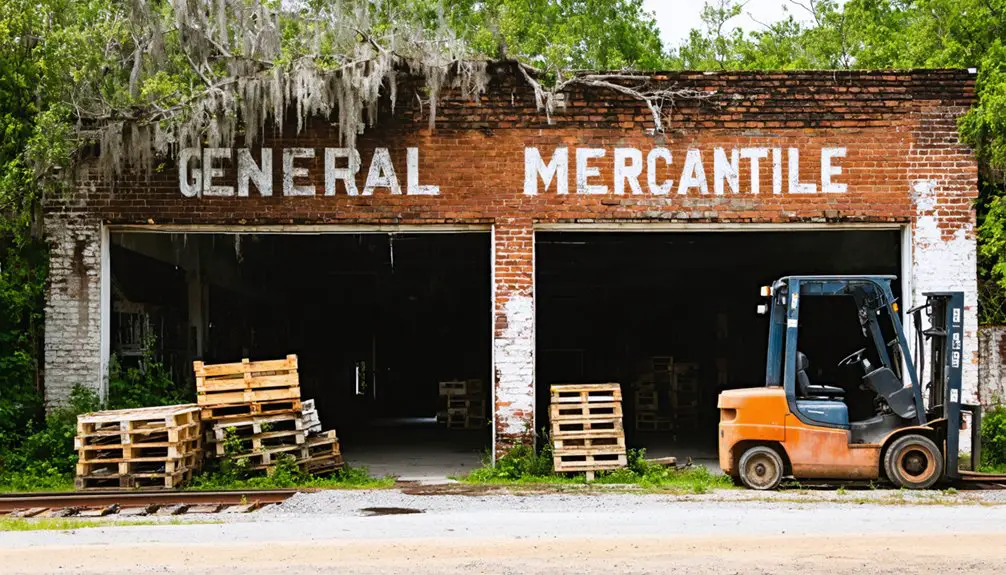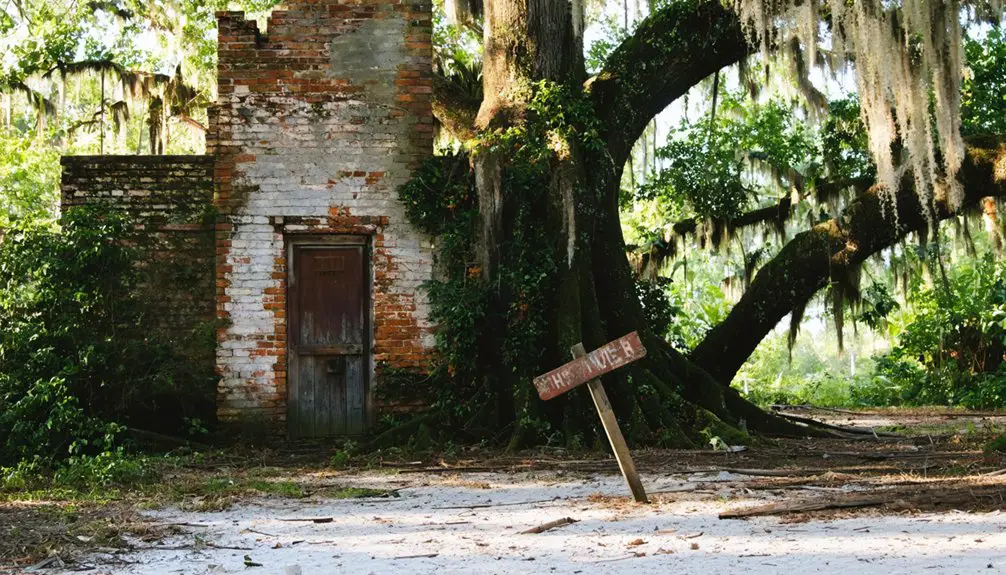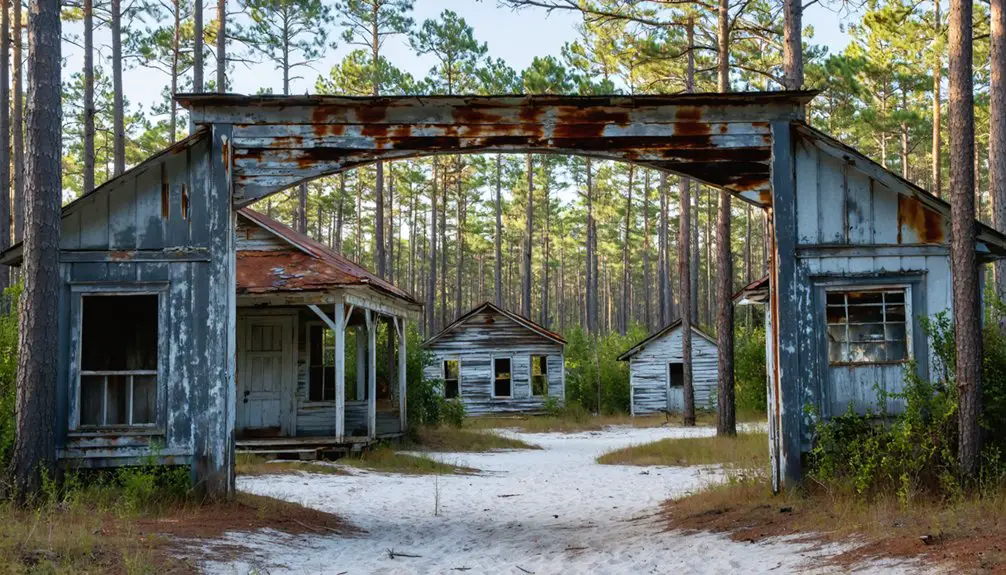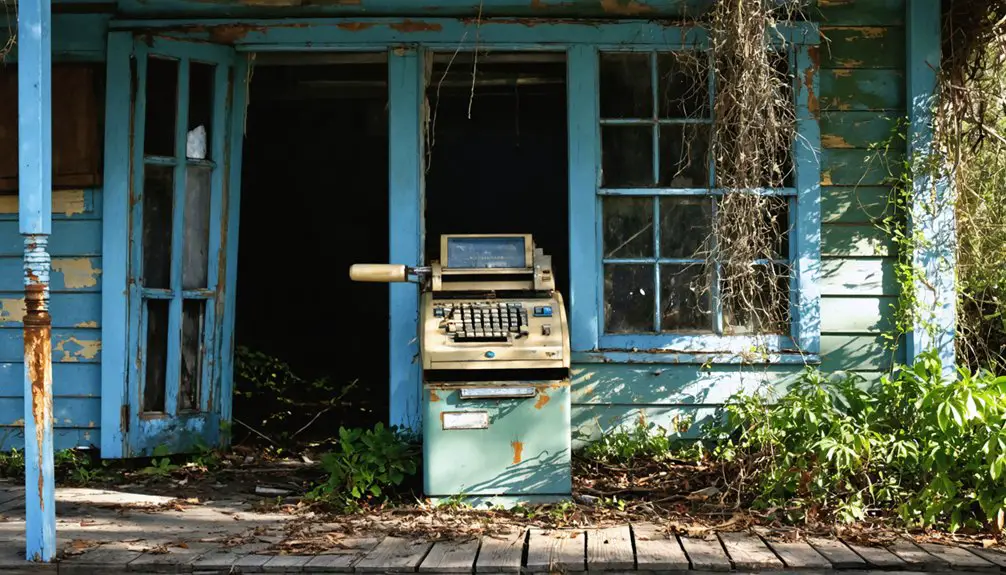You’ll find Aurytown’s mysterious remains hidden within Florida’s dense woodlands, where French privateer Louis Michel Aury established a bustling maritime settlement in 1816. This strategic base supported his privateering operations, generating substantial wealth through captured cargo worth $778,000 in coins and indigo. While the exact location remains contested, archaeological evidence includes building foundations and a cemetery beneath the vegetation. The site’s complex history of piracy, trade, and maritime operations holds countless untold stories.
Key Takeaways
- Aurytown was a 19th-century Florida settlement established by French privateer Louis Michel Aury as a base for maritime operations.
- The exact location remains a historical mystery, though believed to be within a densely wooded state park off Causeway Boulevard.
- The settlement thrived on logging, phosphate mining, and agriculture, with a maritime economy centered on privateering and trade.
- Archaeological evidence includes building foundations and a cemetery, with systematic excavations beginning in the late 20th century.
- The town declined after 1845 due to increased U.S. Navy presence and competition from major ports like Pensacola and Tampa.
A Privateering Past: Origins and Maritime Significance
When you trace the origins of Aurytown, Florida, you’ll find its roots in the ambitious privateering career of Louis Michel Aury, a French naval officer turned privateer who established strategic bases across the Gulf of Mexico and Caribbean in the early 19th century.
Aury’s exploits began in 1816 when he established a formidable privateering base at Galveston Island, commanding a fleet of eight ships and generating substantial wealth through maritime piracy. You can measure his success by the staggering $778,000 in captured cargo, including coins and indigo. His collaboration with revolutionary leader Jose Manuel de Herrera secured his position as commissioner of the island. Having served in the French Navy since 1802, Aury developed the maritime expertise that would later define his privateering success.
His strategic vision led him to capture Old Providence Island with 400 men and construct Fort Libertad, demonstrating his commitment to supporting Central American independence movements.
While many of his settlements have vanished, Aury’s legacy as a privateer who challenged Spanish colonial dominance lives on in Florida’s maritime history.
Location Mysteries and Historical Geography
You’ll find that pinpointing Aurytown’s exact location remains one of Florida’s most perplexing historical mysteries, as shifting county boundaries and limited surviving records have obscured its precise coordinates.
Similar to Pine Level’s fate after county seat changes, early settlements often disappeared when administrative centers relocated, making historical mapping even more challenging.
While historical evidence suggests the settlement maintained strategic positioning near essential waterways for trade, the specific waterfront location can’t be definitively established from existing documentation.
Your research into neighboring ghost towns might offer contextual clues, as similar settlements typically emerged along Florida’s historic maritime routes and trading posts. The town’s rumored connection to pirate Louis-Michel Aury adds another layer of uncertainty to its geographical placement.
Strategic Waterway Position
Three key waterways converged near Aurytown’s strategic position on Honeymoon Island’s north side, making it an essential hub for early Florida maritime commerce.
You’ll find this location’s significance embedded in its proximity to both the Atlantic and Gulf Intracoastal Waterways, alongside important channels connecting Florida’s inland routes to the Gulf of Mexico.
The settlement’s waterway preservation efforts proved critical for maintaining economic sustainability, as the community relied heavily on marine traffic for trade and transportation. French pirate Aury established this vital maritime outpost in the early 1800s to capitalize on the region’s strategic waterways.
While you can trace Aurytown’s eventual decline to challenges like shifting shorelines and channel sedimentation, its position within Florida’s 1,350-mile coastline system created lasting impacts on regional connectivity.
The town’s legacy demonstrates how smaller coastal settlements contributed to the broader network of maritime commerce that shaped Florida’s development.
Lost Settlement Coordinates
Despite extensive historical research, the precise coordinates of Aurytown remain one of Florida’s most perplexing geographical mysteries.
You’ll find the lost coordinates somewhere within a densely wooded state park area, accessible only by foot from Causeway Boulevard near Dunedin. While a 1979 report documents numerous historical artifacts at the suspected site, the exact location continues to elude researchers. Like the nearby Fort Jefferson ruins, the area holds significant historical importance but presents unique preservation challenges. Many early Florida settlements like Aurytown underwent county boundary changes as territories evolved.
Archaeological challenges compound the mystery, as metal detector restrictions and natural landscape changes have limited modern verification efforts.
You can explore the paths visible in aerial photographs, but they only hint at previous settlement patterns without confirming exact locations.
The heavily wooded terrain and coastal environmental changes have obscured potential structural remains, making it difficult to pinpoint where this fascinating piece of Florida history once stood.
Life in a Pirate Settlement
While historical records paint an incomplete picture of daily life in Aurytown, it’s understood the settlement operated as a bustling hub of illicit trade and naval operations under Louis Michel Aury’s command.
You’d find a basic settlement structure consisting mainly of tents along sandy shores, where crews lived under a strict pirate hierarchy. The area resembled other pirate strongholds along the west coast of Florida. Daily routines revolved around naval campaigns and the processing of captured goods.
In this bustling haven, you’d witness armed men preparing for expeditions while others managed stockades holding enslaved people and valuable cargo. The deep harbor at Fernandina Port facilitated hundreds of trading vessels simultaneously.
The settlement’s economy thrived on smuggling operations, with traders paying hefty sums for contraband and slaves. Monthly profit-sharing kept the crews loyal, though leadership remained precarious, as evidenced by Aury’s eventual loss of control in other territories.
Strategic Importance During Spanish-American Conflicts
Throughout the late 18th century, Aurytown’s location proved essential in Spain’s campaign to weaken British dominance in North America. You’ll find that this settlement’s position along Florida’s strategic waterways played a key role in Spanish strategy, serving as a critical point for monitoring British movements and protecting supply routes.
As local records show, Aurytown’s natural harbor provided Spanish forces with a perfect staging ground for military logistics during Governor Gálvez’s campaigns from 1779 to 1782. Spanish ships delivered 300,000 pounds of gunpowder and other vital munitions through the port to support the war effort.
The town’s residents witnessed countless Spanish ships using their port to coordinate attacks on British positions, particularly during operations aimed at recapturing Pensacola. From here, Spain successfully disrupted British supply lines and communication networks, contributing considerably to their eventual loss of West Florida and weakening their grip on North American territories.
Economic Activities and Trade Networks

As records from local archives reveal, Aurytown’s economic foundation rested heavily on three major industries: logging operations, phosphate mining, and agricultural ventures.
The logging economy dominated local life, with companies controlling wages through company stores and scrip payments. You’d find workers struggling under this closed economic system, which limited their purchasing power and freedom of trade.
Company stores and scrip payments trapped logging workers in a restrictive economic system, limiting their financial independence and buying options.
Agricultural cycles brought brief periods of prosperity through citrus farming, but natural disasters and freezes repeatedly devastated crops. When combined with the boom-bust nature of phosphate mining, these economic activities created an unstable foundation for Aurytown’s growth.
Trade networks remained largely internal, controlled by company stores that provided essential supplies and tools. This limited diversification ultimately left the town vulnerable when industries declined and resources depleted.
The Rise and Fall of Maritime Operations
During the early 19th century, Aurytown emerged as a strategic maritime hub deeply connected to pirate and privateering activities, most notably through its association with the infamous Jean Lafitte.
Maritime legends tell of bustling boatworks, sawmills, and repair shops that supported the town’s seafaring operations while pirate folklore speaks of hidden treasures along its shores.
You’ll find that Aurytown’s decline began as the U.S. Navy increased its presence in Florida’s waters after 1845.
The rise of major ports like Pensacola and Tampa, coupled with technological advances in transportation, drew maritime commerce away from the settlement.
What was once a thriving center of maritime operations eventually succumbed to changing times, leaving behind only whispers of its seafaring past in the structures that still dot the landscape.
Archaeological Evidence and Physical Remains

Today you’ll find limited physical remains of Aurytown, with only a few building foundations and a cemetery visible through the juniper-covered landscape that’s now protected as a state park.
Archaeological investigations have been constrained by metal detecting restrictions and dense vegetation, though a 1979 survey documented several significant artifacts from the site.
The town’s original layout can still be traced through old paths in the wooded area, while regional archaeological patterns suggest the possibility of both Native American and European settlement phases at this location.
Current Site Conditions
The physical remains of Aurytown offer limited but significant archaeological evidence of its past occupation.
Today, you’ll find the site largely obscured by dense Florida vegetation, making site accessibility challenging for researchers and visitors alike.
While state park regulations protect these historical remnants, they also restrict certain exploration methods like metal detecting.
The scattered foundations and cemetery markers that do remain provide vital insights into the community’s layout and daily life.
- Weathered foundation pilings stand as silent sentinels, reminding us of the industrial prosperity that once defined this forgotten town.
- Hidden beneath thick undergrowth, fragments of personal belongings tell intimate stories of former residents.
- Historic cemeteries preserve the names and final resting places of Aurytown’s pioneering families.
- Riverbeds hold secrets of past industrial activities, where artifacts occasionally surface after heavy rains.
Excavation History Overview
Since archaeologists first documented Aurytown’s remains in the late 20th century, systematic excavations have revealed a complex portrait of this former industrial settlement.
You’ll find evidence of the town’s evolution through careful archaeological methodologies, including ground-penetrating radar, stratigraphic digging, and detailed mapping of foundations and artifacts.
The site’s exploration has faced significant excavation challenges, particularly in distinguishing permanent structures from temporary facilities amid mixed industrial and residential debris.
Through collaborative efforts with preservation authorities since 1961, researchers have uncovered remnants of boat works, sawmills, and domestic life.
While metal detecting is now prohibited to protect cultural remains, modern technologies continue to refine our understanding of Aurytown’s layout and timeline, offering glimpses into this resilient community’s daily operations before its ultimate abandonment.
Artifacts and Structural Remnants
Physical remnants of Aurytown reveal a complex tapestry of 19th-century coastal life, though nature has reclaimed much of what settlers left behind.
Through careful structural analysis of foundation pilings and scattered ruins, you’ll find traces of early homesteads and industrial sites hidden beneath the forest canopy. While artifact preservation remains challenging, the 1979 discovery provided significant insights into the settlement’s history, though metal detecting is now prohibited to protect remaining relics.
- Stone foundations whisper stories of determined settlers who carved out their independence along Florida’s wild coast
- Hidden pathways, visible only from above, trace the footsteps of those who sought freedom in this frontier town
- Scattered artifacts remind us of the resourceful spirits who built lives far from civilization’s constraints
- Ancient burial grounds honor the pioneers who made this untamed land their home
Comparing Aurytown to Other Florida Ghost Towns

While many Florida ghost towns boasted substantial populations and infrastructure, Aurytown stands apart as a uniquely maritime settlement with distinctly different origins and scale.
Unlike Fort Dade’s 600 residents or Koreshan’s 200-strong religious colony, you’ll find Aurytown was primarily a privateering base without the extensive community buildings or industrial facilities common to other ghost towns.
Aurytown diverged from Florida’s typical ghost towns, operating solely as a privateering outpost rather than a full-fledged community.
The contrast becomes even clearer when you compare Aurytown’s maritime focus to places like Fort Dade, with its hospital and entertainment venues, or Koreshan’s diverse economic activities including bakeries and sawmills.
While other ghost towns declined due to economic downturns, natural disasters, or changing demographics, Aurytown’s fate was sealed simply by the end of privateering operations in the early 19th century, making it a unique chapter in Florida’s ghost town history.
Historical Legacy and Maritime Heritage
Established in 1816 by privateer Juan Aury, Aurytown’s maritime legacy represents a fascinating intersection of privateering, international trade, and territorial conflict in early American history.
The settlement’s cultural impact echoes through maritime folklore, reflecting a time when the line between legitimate commerce and sanctioned piracy blurred along Florida’s contested shores.
You’ll find Aurytown’s story woven into the fabric of early American maritime heritage, showcasing the spirit of independence that characterized frontier settlements.
- The town’s strategic position made it a symbol of resistance against colonial powers
- Local maritime traditions celebrate Aury’s legacy as both privateer and merchant
- The settlement’s brief existence captures the untamed spirit of early Florida
- Aurytown’s story embodies the region’s evolution from frontier outpost to established territory
Frequently Asked Questions
What Happened to the Families Who Lived in Aurytown?
While some families stayed connected to their roots through historical records, you’ll find most relocated to nearby towns with stronger economies or urban centers seeking better opportunities.
Were Any Pirate Treasures Ever Found Near Aurytown?
While treasure maps have led to searches, you won’t find verified discoveries of Aury’s lost artifacts near the area. Despite claims from treasure hunters, no confirmed pirate treasures have been documented.
How Did Locals View the Privateers Operating From Aurytown?
While you’d think locals despised privateers, they actually held mixed views – welcoming the boost to their local economy while remaining wary of the privateer reputation for disrupting Spanish control.
Did Any Famous Pirates or Privateers Specifically Call Aurytown Home?
You’ll find only Luis Aury definitively linked to Aurytown among privateer legends. Despite tales of other Aurytown pirates visiting, no historical records confirm any other famous privateers made it their permanent home.
What Natural Disasters Affected Aurytown During Its Brief Existence?
Like a cruel twist of fate, you’ll find records of hurricane impact devastated the coastal settlement repeatedly, with flood damage destroying homes and infrastructure. Storms and harsh winters likely hastened its abandonment.
References
- https://www.clickorlando.com/features/2024/09/25/floridas-creepiest-ghost-town-is-stashed-on-an-island-heres-the-lowdown/
- https://www.youtube.com/watch?v=SfNW9rjRUbQ
- https://freepages.history.rootsweb.com/~gtusa/usa/fl.htm
- https://patchproflorida.com/blog/the-fascinating-history-of-floridas-ghost-towns/
- https://www.youtube.com/watch?v=ov9YSsKtbDs
- https://www.galvestonmonthly.com/history/aury.html
- https://en.wikipedia.org/wiki/Louis-Michel_Aury
- https://nassauflorida.com/blog/article/pirates-flags-and-buried-treasure-folklore-of-amelia-island
- https://floridatraveler.org/2016/07/26/floridas-pirate-legacy-myth-or-reality/
- https://www.treasurenet.com/threads/another-tampa-bay-pirate.535619/



